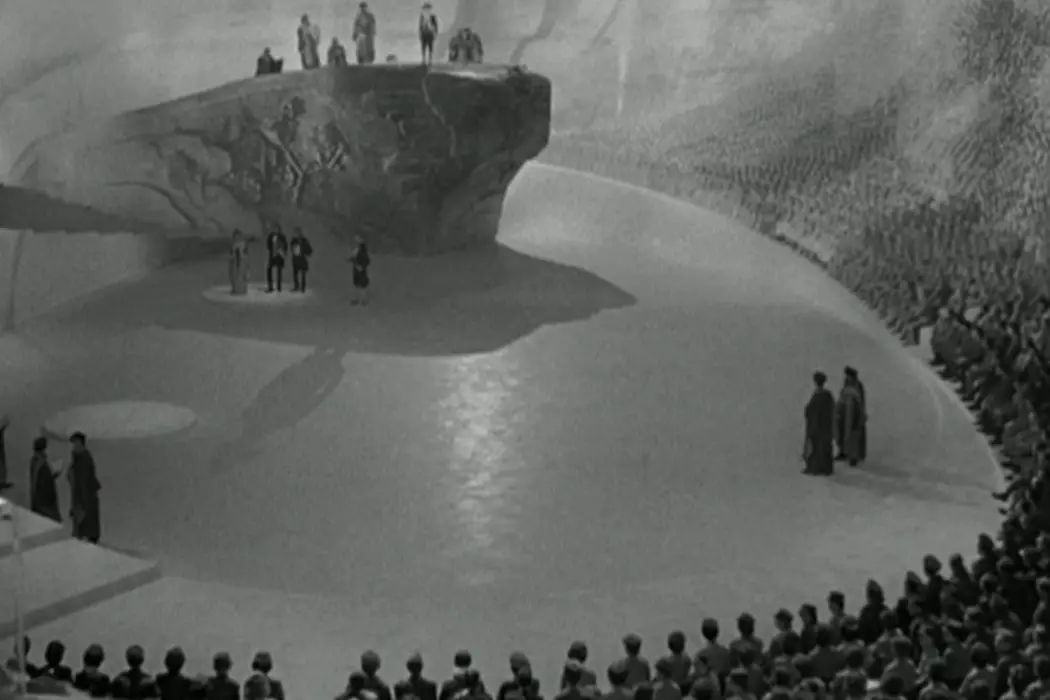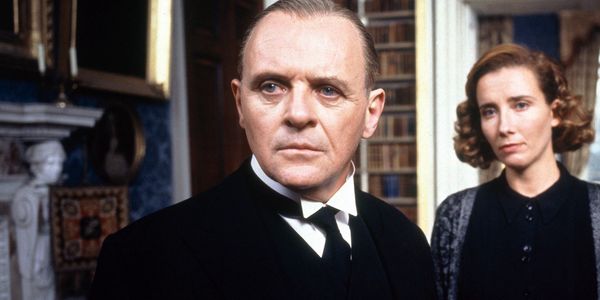The History of British Cinema Part 1: The Rise Of The Studio Film

Tom is a recent graduate based in the UK, who…
Although British cinema began before the turn of the Twentieth Century, it was after the calamity and turmoil of World Wars I and II that it was truly born as a distinct artistic and economic entity.
The wars forced filmmakers to take genres that had only been invented and pioneered relatively recently, such as the documentary or action film, and use them to explore what it meant to be British during and after such a conflict. But whilst the wars necessitated in the development of cinema that could help a nation process its grief, the post-war period needed something else – distraction, diversion and entertainment. It was from this necessity that the legendary British film studios were born.
The Gainsborough Melodramas
The first major studio that pioneered their own genre of film was Gainsborough Studios, based in London, which was founded in 1924. Although it produced a plethora of films between its foundation and its closure in 1951, it is most famously remembered for the Gainsborough melodramas, a collection of films produced in the 1940s. These films became incredibly popular, despite – or perhaps because of – the war that was still raging when they were first released.
Nearly all of the films are period pieces, such as Fanny by Gaslight and Caravan which are based in the late 1880s. The use of period in many of the films is comparable by the more recent genre of Heritage films, which glorify real or fictitious events set in an idolised and nostalgised past that interacts with the present of the film’s release. By setting many of the melodramas in a simpler yet recent past, the producers appealed to the commonly held post-war desire for the simplicity and luxury of pre-war life.

Many of the themes featured in the films also harken back to Victorian literature, with stories exploring love across class (The Man in Grey) or the societal expectations for women at the time (Madonna of the Seven Moons). Doing so has the same effect as setting the films in these times, although some films have added prescience for their themes also being related to war-time troubles. For example The Man in Grey features a couple who are descended from doomed lovers – the enduring nature of love presented by this couple harkens to the war’s nature of splitting up bonds.
The power of the Gainsborough melodramas came from their simplicity. Whilst the war was causing many to ask complex questions about humans’ inhumanity to each other, the melodramas focused on simple tales with small casts – so much so that some famous actors, such as James Mason, Margaret Lockwood and Phyllis Calvert, worked on the majority of them.
A lot of the stars of the films were women, but this gender equality was even more notable behind the camera. Most of the films were adapted from novels written by women, such as Eleanor Smith and Dorothy Whipple, and prolific producer Betty Box is considered now one of the most influential British producers of all time (and she was the only major female producer operating when she made the films). Unfortunately, the progressive nature of the films didn’t progress beyond gender – blackface and other insensitive racial issues plagued several of the films.
The Ealing Comedies
Another major name in the studio film boom was Ealing Studios, a London-based studio that started in 1902. Ealing still produces films, TV and music videos to this day, but one of the most important eras of its history was the popularity of the Ealing comedy. Beginning in 1947, the year after the final commonly-accepted Gainsborough melodrama was released, the genre combined British whimsy and post-war anxieties to popular and critical acclaim.

One of the most important themes of the films is that of community. In films such as Whisky Galore! and The Titfield Thunderbolt, rural communities must band together to continue to practice their customs against the will of outside forces. Similarly, A Run for Your Money plays with stereotypes of Welsh people in an affectionate way to comment on the divide felt between the countries. Since post-war Britain was in the process of rebuilding its communities and culture, films that explored the power of people were an important motivational force for film-goers.
Unlike the majority of the Gainsborough films, the Ealing comedies didn’t shy away from the war – such as Whisky Galore! and Passport to Pimlico which both explore issues of rationing during the war. In the latter, newly discovered documentation shows that an area of Pimlico in London actually belongs to Burgandy, and therefore isn’t affected by rationing legislation. The fact that comedies explored issues that affected the lives of those suffering in the aftermath of war, with both films doing so through a fantastical spin on the issue, shows that the war was still an important issue in cinema – whether a film was looking at the topic or intentionally shying away, as was the case with Gainsborough.
However, communities and groups weren’t the only heroes in Ealing comedies. In The Ladykillers, a sweet old lady foils the plots of her mischievous tenants. In The Magnet and Hue and Cry, children must learn morality and personal agency through various trials. Normal everyday people were the heroes of the films just as much as communities were, which contrasted with the Gainsborough melodramas that put the higher classes on a pedestal through period drama.

This penchant for the power of people, be it in communities or individuals, was the real draw to the Ealing films – it inspired a much-needed sense of community in the years following the war, and encouraged people to band together to rebuild the country.
Where Gainsborough melodramas were pure escapism, Ealing comedies used a lighthearted approach to deal with the issues. The popularity of both could be due to the timing of both cycles – the films considered Gainsborough melodramas were all released during or immediately after the war, whereas Ealing comedies truly began in 1947, once it had finished, and with two years of hindsight.
The Studios’ Legacy
The popularity of both of these strains of studio film can be compared to modern day trends in cinema. Although to directly link cinematic movements over half a century would be a foolish overstatement, various elements of both Gainsborough melodramas and Ealing comedies can be seen in films to this day.
Gainsborough melodramas, being mostly period pieces, have a lot in common with the British Heritage film movement. The term ‘Heritage film’ refers to a film that glorifies Victorian-era Britain, usually through a conservative slant, and has been used to describe films from Chariots of Fire to The Remains of the Day and The King’s Speech. Gainsborough period pieces retain the view of history as exclusively upper-class that Heritage films do – in The Wicked Lady and Fanny by Gaslight all the main characters are Sirs or Ladies or Lords, and the stories follow the various misadventures of rather well-off people.

Of course, not all period films are Heritage films. The term is used exclusively to nostalgised views on the past, and ones that are without any anachronism or social commentary that is prescient at the time of release.
The main difference between Gainsborough period pieces and Heritage films is purely the genre – whilst Gainsborough films invest fully in the melodrama of the story (the Wikipedia plot summary to The Wicked Lady attests to this, every new paragraph is a knot of plot twists and betrayals), Heritage films choose to focus on either the romance or drama, instead of both.
Ealing comedies have a far clearer lineage in the influence they’ve had on future British comedies. The power of community is a common trope in British comedy films, with notable examples including Brassed Off and Pride. In particular, the conflict between a community and outside perceived threats has been explored in films such as The Englishman Who Went up a Hill but Came Down a Mountain.
Comedies like these help a community explore their differences to other parts of the same country – many of these films are set in Ireland or Wales, and the divergent cultures despite the small size of Britain creates conflicts that the films can explore. In particular these films are aimed at audiences from these cultures – in The Englishman Who Went up a Hill but Came Down a Mountain, which is set in Wales, there’s a joke in the Welsh language which flies under the radar for anyone who isn’t fluent.
It’s likely that, regardless of the existence of Ealing comedies, there would be films that explored the way communities interact with themselves and with the outside world. However, it’s undeniable that the Ealing films paved the way for the particular brand of self-celebratory comedy that these and many other films enjoy.
However, there was another cinematic force after World War II that had as much, if not more, impact on cinematic history. A powerful force in cinema in the post-year wars was the two-man production company The Archers, which consisted of Emeric Pressburger and Michael Powell. Their dramatic films didn’t use the veil of genre to distract from the war, but explored it in intense detail to create some of the most well-remembered war films.

Their films, which include A Matter of Life and Death and A Canterbury Tale, didn’t use a particular genre repeatedly to distract or entertain audiences. The former explores the effects of the war on a man but also tracks this theme through various other wars and decries the bureaucracy of war and death. Although the film is at its core a love story, the disgusted view of war is the main theme.
Conclusion
The rise of studio films as important cinematic movements had no previous precedent in the history of British cinema, but the economic success of a series of thematically linked films would clearly be at home in the twenty-first century. Using the same sets, recurring crew and casts, and stories that spoke to British experiences in the war, the studios could mass-produce content that was guaranteed to make money.
However, the studio films shouldn’t be remembered as the genesis of capitalist-inspired cinema – not least because they aren’t. They should be remembered as the roots of many elements and dispositions that have recurred in British films in the half-century since.
British cinema didn’t stay in the era of studio films for long, however. When Gainsborough moved to Pinewood in the late 1940s, and Ealing was taken over by the BBC in 1955, the cinematic environment took a sharp left turn into one of the strangest and wackiest, yet most genuine-feeling, periods of British film ever – the Free Cinema Movement.
What are your thoughts on the studio era of British film history?
Does content like this matter to you?
Become a Member and support film journalism. Unlock access to all of Film Inquiry`s great articles. Join a community of like-minded readers who are passionate about cinema - get access to our private members Network, give back to independent filmmakers, and more.
Tom is a recent graduate based in the UK, who writes about films and games, and makes a few of his own. If he's not watching a film, playing a game or writing a script - don't worry! - he's probably just gone to make a cup of tea. He's never far from a screen.












